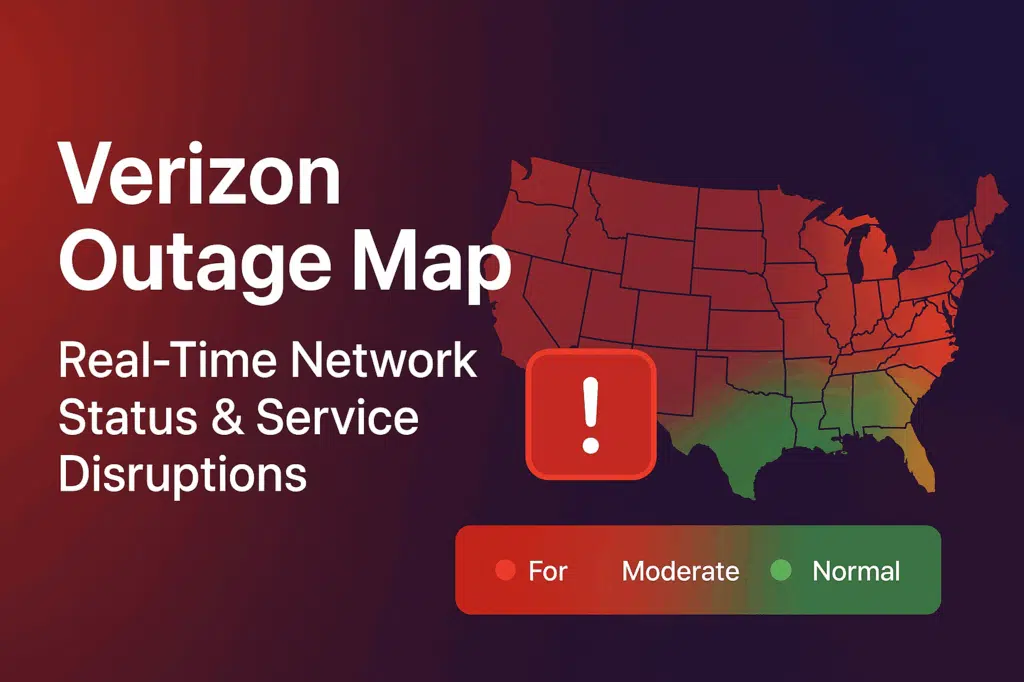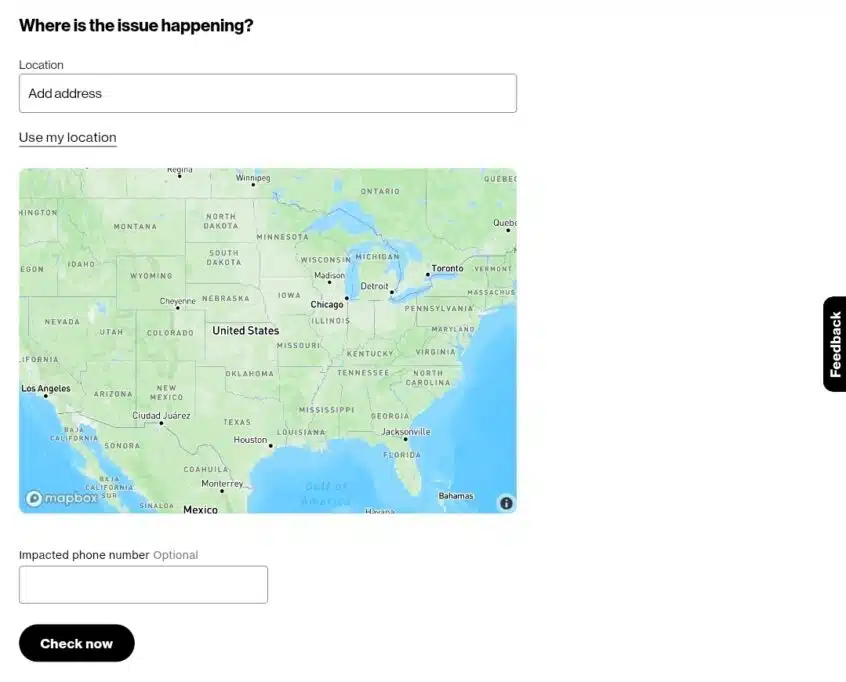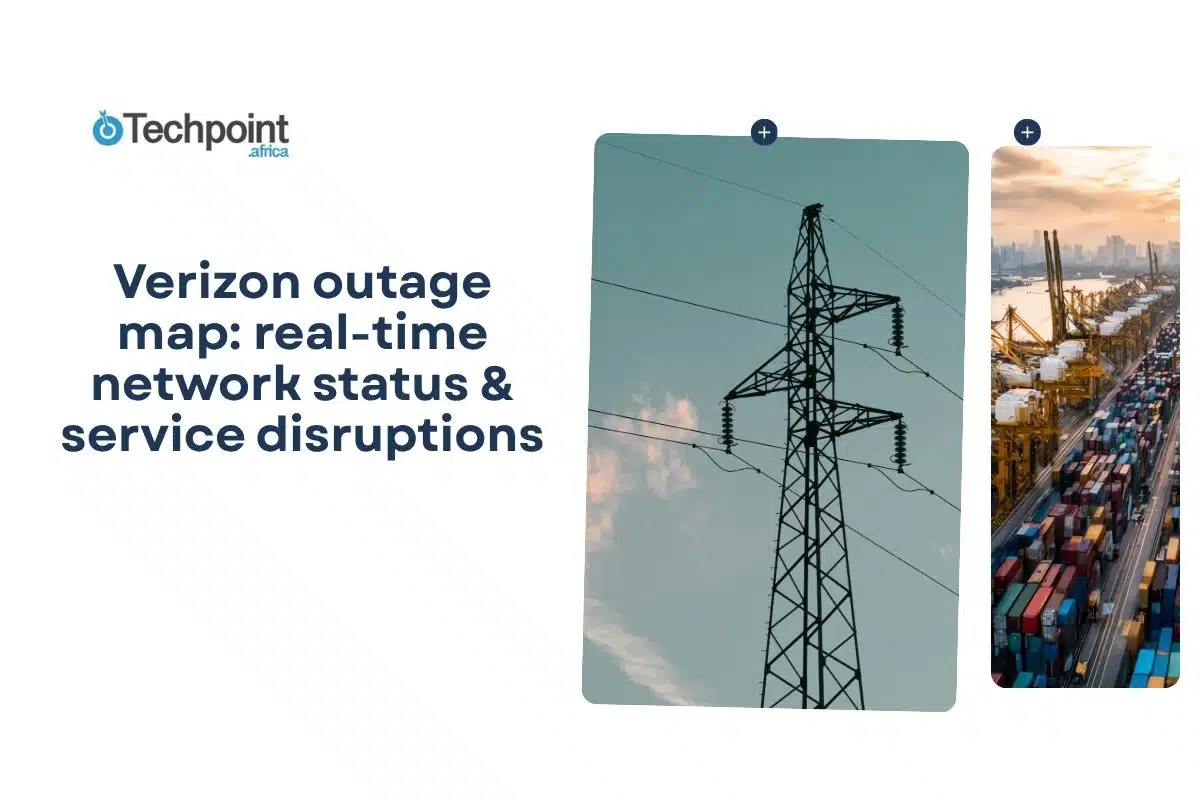
It always hits at the worst time; your calls drop, texts hang, and the internet slows to a crawl. Before blaming your phone, most people type one thing: “Verizon outage map.” With millions relying on Verizon’s vast network daily, even a short disruption sparks nationwide searches. This guide breaks down how to check Verizon’s real-time outage map, interpret updates, and stay connected when the network falters.
In this guide you will learn:
- How to use the Verizon outage map to confirm network disruptions in your area
- The main causes of Verizon’s service outages and how long they typically last
- Simple troubleshooting steps to rule out device issues before reporting an outage
- The fastest ways to report a Verizon outage and stay connected in the meantime
Understanding the Verizon outage map
When Verizon’s network dips, users want answers fast. The Verizon outage map gives a real-time view of reported issues across the U.S., using both official updates and crowdsourced data. It pinpoints where disruptions are happening, whether in Fios home internet, mobile data, or 5G coverage.
Color-coded zones make it easy to spot what’s going on:
- 🔴 Red shows high outage concentration (major disruptions)
- 🟠 Orange signals moderate reports
- 🟢 Green means normal service
These maps refresh every few minutes, combining data from sources like Downdetector, social media mentions, and Verizon’s official status system. The result is a fast, user-driven snapshot of what’s happening, often surfacing issues before Verizon posts official confirmation.
You’ll also find interactive elements: zoom controls, city search bars, and timestamps that show how issues spread or resolve over time. It’s a useful tool not just for current problems but also for seeing historical trends in network reliability.
Checking real-time Verizon network status
When your phone’s acting out (no bars, data dropping), the first thing to do is see whether the problem lies with Verizon or just with you. Here’s how to use Verizon’s tools (and what to expect) to check your status in real time.
Verizon’s official “check network status” tool
Verizon provides a status checker on its site to help customers determine if there’s a known issue in their area.
Here’s how to use it:
- Go to Verizon Support → Check Network Status.
- Enter your ZIP code or use “Use my location.
- Choose among categories: Mobile, Home Internet / Fios, etc.
- The tool returns one of a few possible statuses:
- All systems normal (no issue detected)
- Known issue in your area (sometimes with an estimated restore time)
- Limited service for certain systems (data, voice, text)
- If you have an open repair request, you can also check that status.
For Fios / home internet, Verizon has a separate check-tool flow.

What you’ll see & what it means
- “No known issues” message: Great, according to Verizon, no widespread outage. That doesn’t guarantee your service is fine, but it means the fault may be localized.
- “Known issue” alert: Verizon has logged a disruption in your ZIP or region. It might give you an estimated resolution time (though that’s always a soft guess).
- Service “limited”: Sometimes only voice, or only data, or only texting is impacted.
- Inconsistent behavior: Some users report that the tool shows problems even when they don’t see service loss. One Reddit user said:
“The majority of them are displaying a service outage … I am skeptical of the data it returns.”
Third-party outage trackers as early detectors
Verizon’s tool is solid, but not always the fastest to catch emerging issues. But third-party maps also help:
- Downdetector: A go-to for visual heatmaps and user reports.
- Outage.report and similar sites: aggregate social media + user flags.
- News sites often embed these maps when Verizon has widespread problems.
When a major outage hits, these maps sometimes detect it faster than Verizon’s own system. For example, recently in Chicago, tens of thousands of users reported trouble, and the Downdetector map showed red zones before the official page acknowledged it.
Common Verizon service issues
Not every dropped call or frozen video means a full-blown Verizon outage. Sometimes it’s a local hiccup, a tower glitch, or even a phone setting gone wrong. Here are the most common problems customers report and what they usually mean.
| Issue Type | Typical Symptoms | Possible Cause | Quick Check / Fix |
| No Signal / “SOS” Mode | Your phone shows No Service or SOS only. | Tower maintenance, regional outage, or SIM misread. | Toggle airplane mode, restart your phone, and check if others nearby have service. |
| Data Not Working | Calls go through, but mobile data won’t load. | Network congestion or data center issues. | Reset network settings or switch between 5G/LTE to refresh the connection. |
| Slow 5G or LTE Speeds | Bars look fine, but browsing crawls. | Overloaded tower or backhaul problem. | Run a speed test, then compare at another location. |
| Fios Internet Down | WiFi won’t connect or Ethernet has no link. | Fiber cut, power failure, or router malfunction. | Check ONT lights and reboot the modem/router. |
| Dropped Calls | Calls connect but cut out midway. | Weak signal handoff between towers. | Try moving outdoors or enabling WiFi calling. |
| Visual Voicemail Not Loading | The voicemail app won’t refresh or play messages. | Temporary server outage. | Dial voicemail directly while Verizon resolves backend issues. |
Most of these glitches resolve within minutes, often by simply restarting your device or toggling airplane mode. But if none of that helps and the problem matches what others nearby are seeing, it’s time to check the Verizon outage map for confirmation.
Is it an outage or your device?
It’s easy to assume Verizon’s down when your signal suddenly vanishes, but not every glitch is a network failure. Sometimes the fix is closer than you think. Before sounding the alarm, run through a few quick checks, they solve more issues than most people expect.
Quick troubleshooting checklist
Before you assume it’s a Verizon outage:
- Restart your phone or modem; this alone clears up nearly 40% of user-reported issues.
- Toggle airplane mode on and off to force a new connection.
- Check whether friends or neighbors on Verizon are also affected.
- Make sure your bill’s paid and your line isn’t suspended (it happens).
- Update carrier settings (on iPhone) or reset network settings (on Android).
- If possible, test your SIM card in another device to rule out phone hardware.
Signs it’s definitely a Verizon outage
- Multiple users in your area report the same problem online.
- Verizon’s official status page shows active issues in your ZIP code.
- The outage appeared suddenly and affects all devices, not just one.
- Service resumes when you move to a different area.
- Verizon support confirms ongoing maintenance or network work.
Signs it’s likely your device or account
- You’re the only one seeing the problem.
- Reboots and SIM swaps don’t change anything.
- The issue follows a recent phone drop, damage, or water exposure.
- Calls work on WiFi but not on mobile data, indicating an issue with settings rather than service.
A few minutes of checking can save you hours of waiting. Once you’re confident it’s not on your end, it’s time to let Verizon know.
How to report a Verizon outage
Once you’ve confirmed the issue isn’t on your end, the next step is to report it. Doing this not only gets your own problem logged but also helps Verizon identify larger outages faster. There are several ways to do it — some quicker than others.
My Verizon app (fastest method)
If your phone still connects to WiFi, open the My Verizon app.
- Tap the Menu (☰) → Report a Problem.
- Choose your issue type — wireless, internet, or billing.
- Add notes and photos if relevant (for Fios equipment).
- The app logs a ticket and updates you through push notifications as Verizon investigates.
This is the quickest route for individual reports.
Verizon website
Visit the Verizon Support page and sign in.
- Select Network & Service Issues.
- Follow the guided steps to confirm an outage or open a repair ticket.
- You’ll receive an update once it’s resolved or escalated.
Call customer service
If you can’t connect online:
- Wireless: 1-800-922-0204
- Fios/Home Internet: 1-800-VERIZON (1-800-837-4966)
- Business: 1-800-VZ-BIZ-4U (1-800-829-4948)
Tip: Use WiFi calling if your cellular line is down.
Social media support
Verizon’s support team is active on X (Twitter) @VerizonSupport and Facebook.
- Send a DM with your ZIP code, the affected service, and when the issue began.
- They usually reply within an hour, faster during major outages.
What to include when reporting
- Your location (city, ZIP, or address)
- Phone number or account ID
- Service type (voice, data, or both)
- When the problem started
- Any error messages or patterns you’ve noticed
Providing these details speeds up troubleshooting and helps Verizon’s engineers zero in on trouble spots.
What causes Verizon outages?
Even with one of the most reliable networks in the U.S., Verizon isn’t immune to hiccups. Outages happen for all sorts of reasons, some predictable, others completely out of left field. Understanding what causes them helps set expectations when the map lights up red.
Infrastructure issues (About 40% of Outages)
The backbone of Verizon’s network relies on thousands of cell towers, fiber cables, and data centers.
- Fiber cuts from construction work or rodent damage can knock entire areas offline.
- Tower equipment failures, like power supply or antenna faults, are common in remote regions.
- Occasionally, core switch or routing problems in data centers ripple out across states.
Most of these get fixed within hours, depending on how accessible the damaged site is.
Weather-related disruptions (Around 25%)
Storms remain one of Verizon’s biggest challenges.
- Hurricanes, ice buildup, or lightning strikes can disable towers or flood underground fiber routes.
- Extreme heat sometimes overheats radio units and causes brief shutdowns.
- Heavy snow or wind can damage overhead lines or antennas.
When it’s weather-related, restoration often takes longer because safety crews need clearance before repairs.
Technical or software faults (20%)
Every network runs on code, and sometimes updates misfire.
- Faulty firmware pushes or routing errors can cause authentication failures.
- DNS or database outages disrupt connectivity nationwide.
- Verizon usually resolves these faster since they’re handled remotely by engineers.
External and human factors (10%)
Not all outages start inside Verizon’s network.
- Utility power failures, vehicle accidents, or construction incidents often hit cell sites indirectly.
- Rarely, cyberattacks or DDoS attempts can also trigger regional slowdowns.
Planned maintenance (5%)
Routine maintenance and tower upgrades usually happen overnight. Verizon typically posts advance notices, though some users still feel short service drops while engineers swap hardware or integrate new 5G nodes.
How long outages usually last
| Outage Type | Typical Duration |
| Local tower issue | 2–6 hours |
| Fiber cut or power fault | 4–8 hours |
| Regional disruption | 6–12 hours |
| Major national outage | 12–24 hours |
| Weather damage | 1–5 days |
| Planned maintenance | 2–4 hours (overnight) |
How long it takes to restore service depends on access to the site, replacement parts, and most importantly, weather.
What to do during an outage
When the map confirms Verizon’s having a rough patch, the goal shifts from waiting to working around it. Here are ways to stay connected until full service returns.
If your Verizon Wireless service is down
- Use WiFi calling: Go to Settings → Phone → WiFi Calling and enable it. You’ll still be able to make and receive calls using any available WiFi connection.
- Switch to messaging apps: WhatsApp, Telegram, Signal, or Messenger all work fine over WiFi.
- Try another network temporarily: If you have a dual-SIM phone, switch to your secondary SIM for data.
- Turn on data roaming (if your plan allows). It can connect you to partner towers nearby.
If your Fios or home internet is out
- Use your phone’s hotspot: Connect your computer or smart TV through your mobile data.
- Head to a public WiFi spot: Libraries, cafés, and coworking spaces are reliable for short downtime.
- Reboot equipment: Power-cycle your router and ONT (Optical Network Terminal).
- Offline mode: Download necessary files and work offline until service stabilizes.
For businesses and remote workers
- Activate your backup ISP or mobile hotspot.
- Divert calls to mobile or VoIP numbers so clients still reach you.
- Log downtime: It can help you qualify for Verizon service credits once the issue’s fixed.
Plan ahead for next time
- Keep a portable power bank charged for modems and phones.
- Consider a dual-carrier setup, Verizon plus another provider for redundancy.
- Enable Verizon outage alerts through your account or app notifications.
Outages are frustrating, but being prepared keeps things moving, especially for work or emergency use.
Verizon vs. Competitors: network reliability
When an outage hits, it’s easy to wonder if the grass is greener elsewhere. Verizon still leads in overall coverage, but other major carriers have narrowed the gap. Here’s how they stack up based on 2024 industry data from Ookla and the FCC’s Network Outage Reporting System.
| Carrier | Average Downtime per Year | Major Outages (2024) | Reliability Score |
| Verizon | 7.5 hours | 4 | 99.92% |
| AT&T | 9.2 hours | 6 | 99.88% |
| T-Mobile | 8.7 hours | 5 | 99.89% |
| Industry Average | 10+ hours | 6–8 | 99.85% |
Where verizon excels
- Widest 4G LTE and 5G Ultra Wideband coverage across U.S. cities and rural regions.
- Fast recovery time, Verizon typically resolves outages faster than peers thanks to its large maintenance fleet.
- Strong fiber backbone (Fios) ensures stable home internet in most urban centers.
Where verizon falls short
- Congestion still hits dense urban zones during rush hours.
- A few legacy DSL areas rely on older infrastructure that’s prone to short drops.
- A larger customer base means outages feel more visible when they do occur.
Despite occasional blips, Verizon’s network remains one of the most stable in the U.S., supported by aggressive 5G rollout and steady infrastructure investments.
Final takeaways
- The Verizon outage map gives real-time visibility into service disruptions, often before official announcements appear.
- Always run quick checks first. Most “outages” turn out to be local device or account issues.
- When it’s confirmed, use reporting channels and WiFi calling to stay connected until service returns.
Conclusion
Network interruptions happen, but information makes them easier to handle. Checking the Verizon outage map lets you see what’s really going on, avoid wasted troubleshooting, and plan around downtime. If your area shows red, report it through Verizon’s app or website and stay tuned for live updates. Bookmark this guide so the next time service flickers, you already know what to do.











